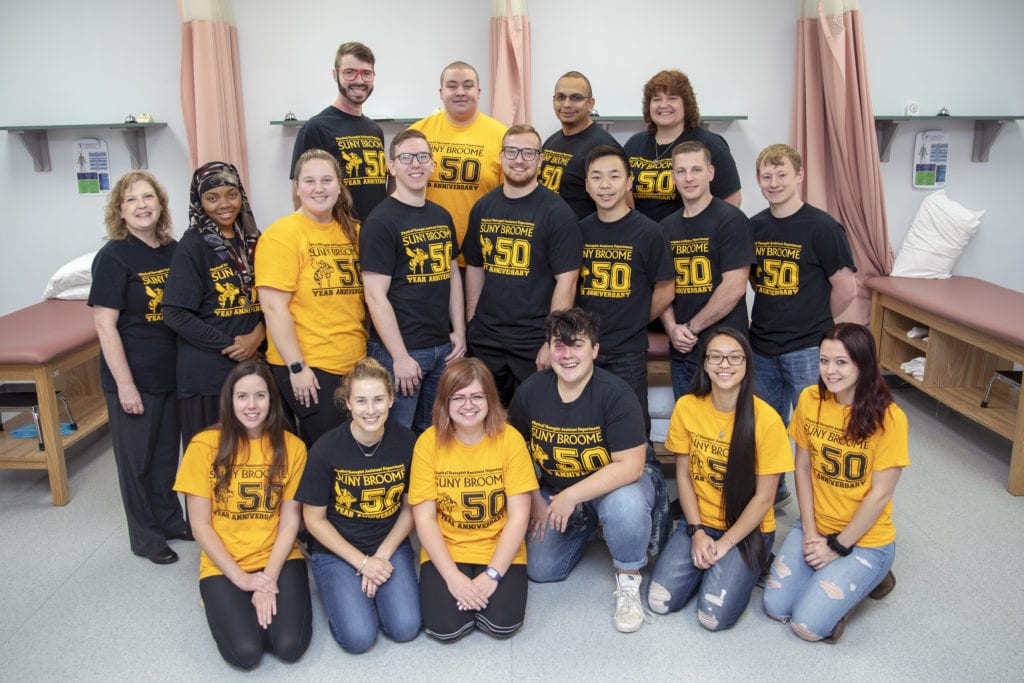
In any physical therapy clinic, you will find devices of all description – elastic bands and inflatable balls, machines and devices that stimulate nerves, bags of ice and balance trainers.
Your guide in this labyrinth of intervention will likely be a physical therapist assistant, or PTA. The profession celebrated its 50th anniversary in 2019. In 2020, SUNY Broome’s own PTA program will celebrate its 30th.
The functional difference between physical therapists and physical therapist assistants is this: Physical therapists can evaluate patients, while PTAs cannot. However, PTAs can and do assist with all of the prescribed interventions.
“We kept growing in terms of what students are able to do under the law. They are evidence-based practices; all our interventions have to be based in evidence,” said Professor Denise Abrams, who chairs the program.
The profession is highly versatile, a fact that draws students such as Suhaillah Haqq of Binghamton. She didn’t learn about the career path until she accompanied her mother on physical therapy appointments, and watched therapists and assistants work with patients. The senior student now wants to specialize in pediatric PT.
“I never realized physical therapy helped so many people. There’s cardiac, pediatric, oncologic and more,” she reflected.
Learn more about SUNY Broome Physical Therapist Assistant degree program!
Get this party started
Dr. Abrams has been involved with SUNY Broome’s PTA program since its start in 1989, when she was first hired as an adjunct teaching introduction to rehabilitation. There were very few PTAs working locally at the time, and she and program founder Nancy Waterman made frequent trips to area clinics, educating the public on the profession.
During those early days, class didn’t meet on campus but at Broome Developmental, where Abrams then worked. Among her students was current Professor Julianne Klepfer, who modeled many of the interventions.
Abrams recruited Klepfer, who joined SUNY Broome’s program as an adjunct in 1994 and went full-time three years later. And as the number of PTAs in area clinics has grown, so too has the number of SUNY Broome students and alumni – helped by New York State law, which mandates a one-to-four ratio between physical therapists and physical therapist assistants.
Back in 1990, the first graduating class consisted of five students – who still stay involved in the program as clinical instructors, Abrams said. Today, classes run up to 26 students. It’s a competitive admissions program, which means numbers are capped – a fact that allows for both personal attention and the use of lab space.
The program is not only competitive, but unapologetically challenging, with 19 credits required for the first semester alone – beyond the full-time requirement of 12. In addition to copious classroom work, students also hone their skills in clinical rotations at facilities throughout the region.
Senior students offer their own tongue-in-cheek description of the program.
“It’s been a party! The party never stops,” Lian McGuane said with a grin.
“Can we say brutal, but rewarding?” Jeffrey Chin added. “We’re always studying.”
Jeffrey is a native of the Big Apple, and came to SUNY Broome for the change of scene – as well as the opportunity to explore different clinical settings. He has always been interested in the field for its versatility, he said.
Chenango Valley High School graduate Lian had her start on the other side of the plinth: as an active athlete who has been in and out of physical therapy in the wake of two knee surgeries. After completing her degree at SUNY Broome, she is considering a transfer to SUNY Morrisville to earn a bachelor of technology in equine science, focusing on equine rehabilitation for therapy.
“This is something I really want to do,” she said. “I came to the program right out of high school.”

Keeping up to date
The first campus labs opened in the Student Services Building and Abrams, by then full-time, had her office in Titchener Hall. She later worked with architects to design the lab space in today’s Decker Health Sciences Building, which opened in 1998.
The current lab and classroom space contains two separate areas, allowing the program to conduct two classes at once. It’s filled with tools of the trade – plinths, exercise balls, balance devices and state-of-the-art technology – as well as a few unexpected items. A Raggedy Ann doll demonstrates low muscle tone in infants. The two ceramic squirrels demonstrate something a little different.
“If we get sidetracked: ‘Squirrel!’” explained Professor Abrams, quoting the cartoon dog from the movie Up.
High-tech items include the Anatomage Table, a 3-D anatomy visualization system that gives students an in-depth look at the body’s systems. The Biodex system can test balance and muscle strength. The program makes a point to keep abreast of the latest technology, to better train the professionals of tomorrow.
“Protocols change and techniques change. We have to keep up to date,” Klepfer explained.

Community Outreach
These days, the students themselves play the role of the profession’s ambassadors. Almost all of the area’s PTAs come through SUNY Broome’s program, Abrams said.
PTA students are active outside the classroom as well, both on campus and beyond. In fact, their efforts helped the New York American Physical Therapy Association’s Southern Tier District bring home the 2018 Golden Goniometer Award for raising public awareness of physical therapy-related issues.
The PTA Club on campus is highly active, with events ranging from a 5K to support disabled veterans to trivia nights, fitness events and more. PTA students also pitch in every October for Physical Therapy Month. In addition to running a food drive for the campus food pantry, they also presented at Calvin Coolidge Elementary School’s fall Healthy Habits Fair in the Binghamton City School District, educating students on “tech neck” prevention and backpack safety.
On the professional development front, PTA students attended the annual New York American Physical Therapist Association conference in Saratoga during the Fall 2019 semester. While there, they attended day-long continuing education courses that focused on Medicare documentation and cardiac pathology and rehabilitation, and networked with clinicians, students, medical equipment vendors, physical therapy-based job recruiters and transfer college recruiters.
While today’s students become tomorrow’s professionals, the program’s professors still keep in touch with developments in the local healthcare community. Clinical rotations give them a unique opportunity to talk to different clinicians and find out not only how students are performing, but area needs and trends.
“We have a strong connection to the community,” Dr. Abrams said.



